2024学年高中英语语法术语课件(共23张PPT)
文档属性
| 名称 | 2024学年高中英语语法术语课件(共23张PPT) |  | |
| 格式 | pptx | ||
| 文件大小 | 291.5KB | ||
| 资源类型 | 教案 | ||
| 版本资源 | 通用版 | ||
| 科目 | 英语 | ||
| 更新时间 | 2023-08-10 20:58:58 | ||
图片预览


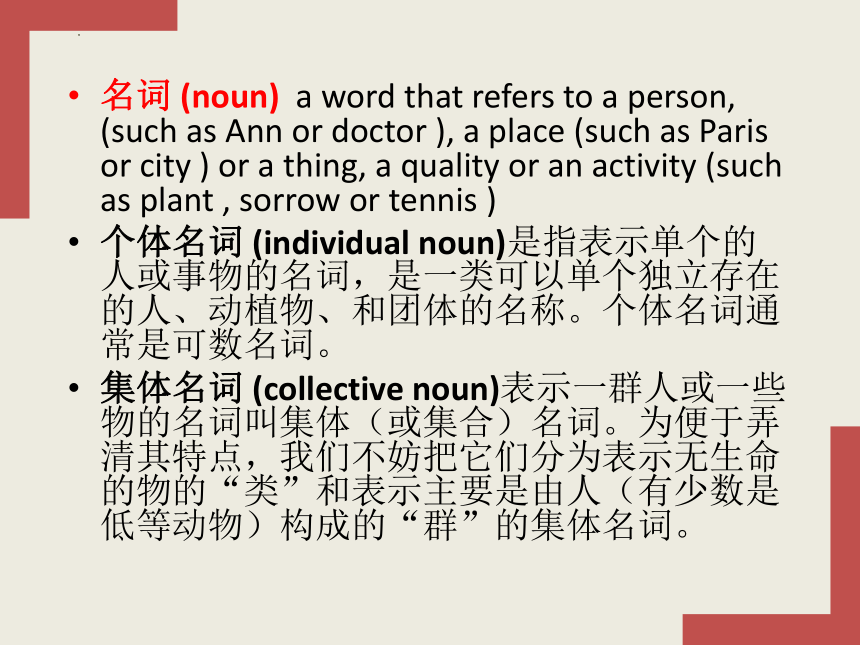
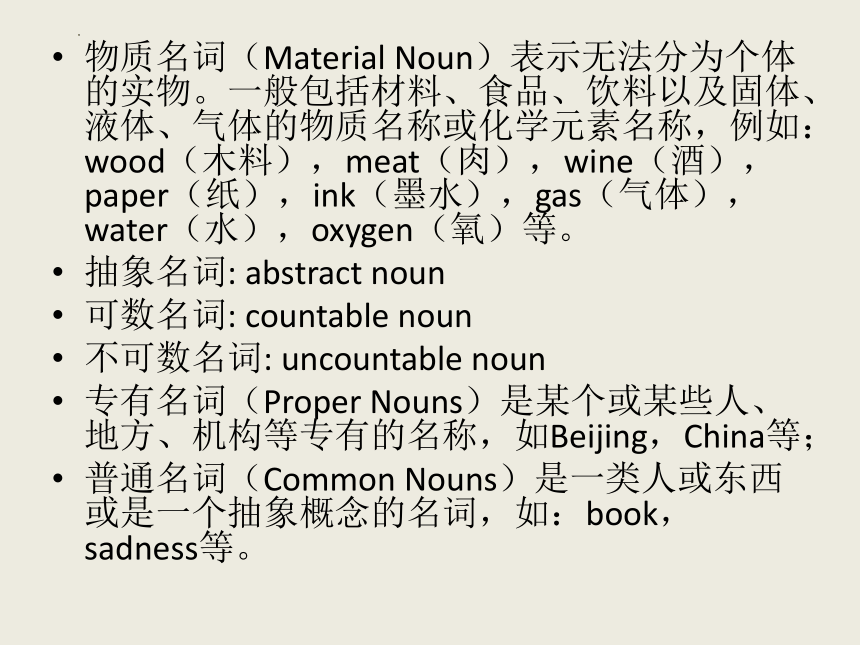
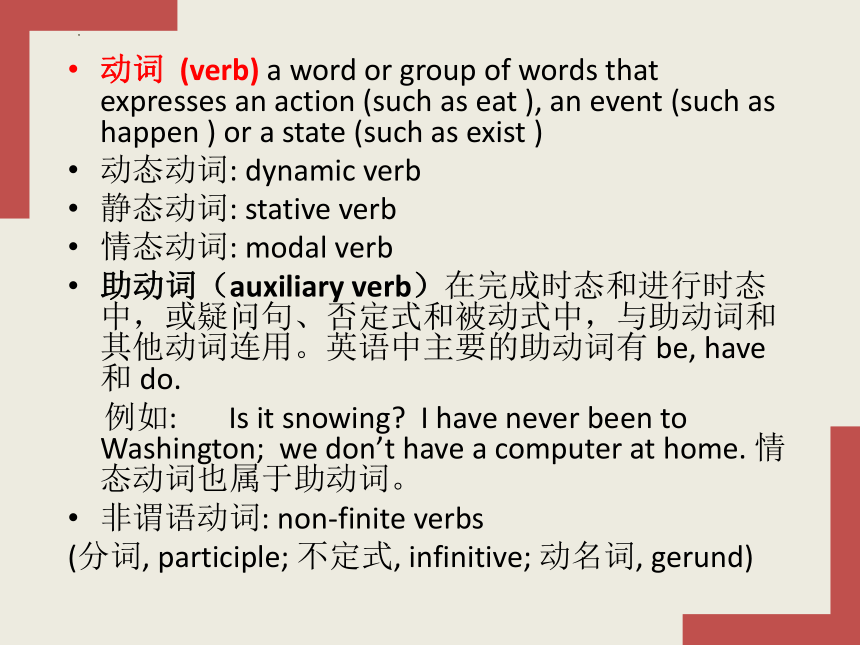
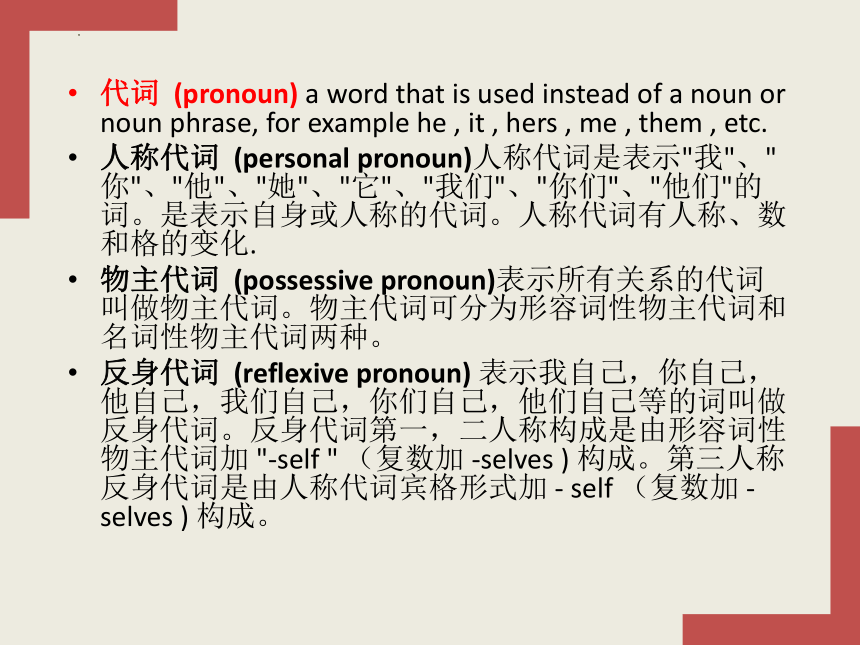
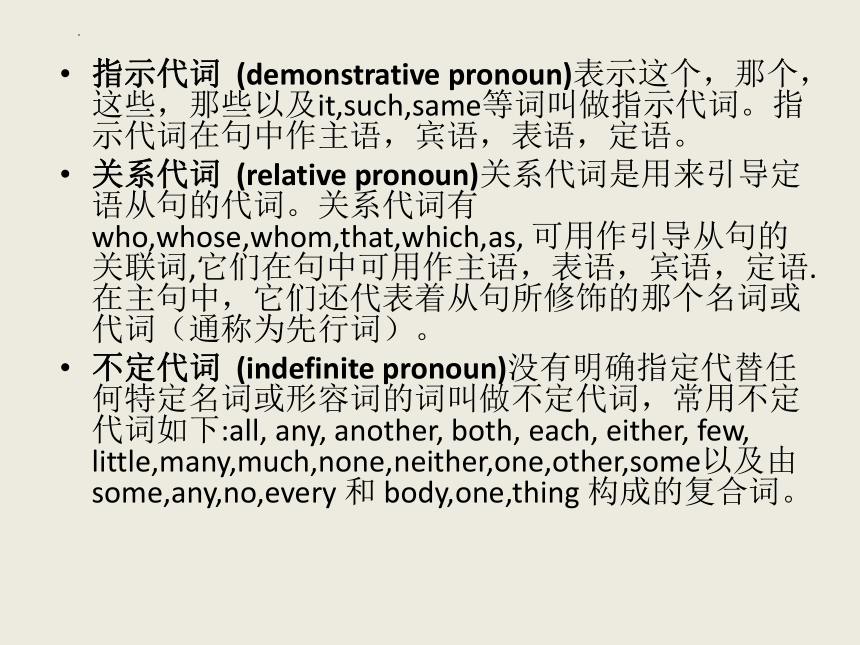
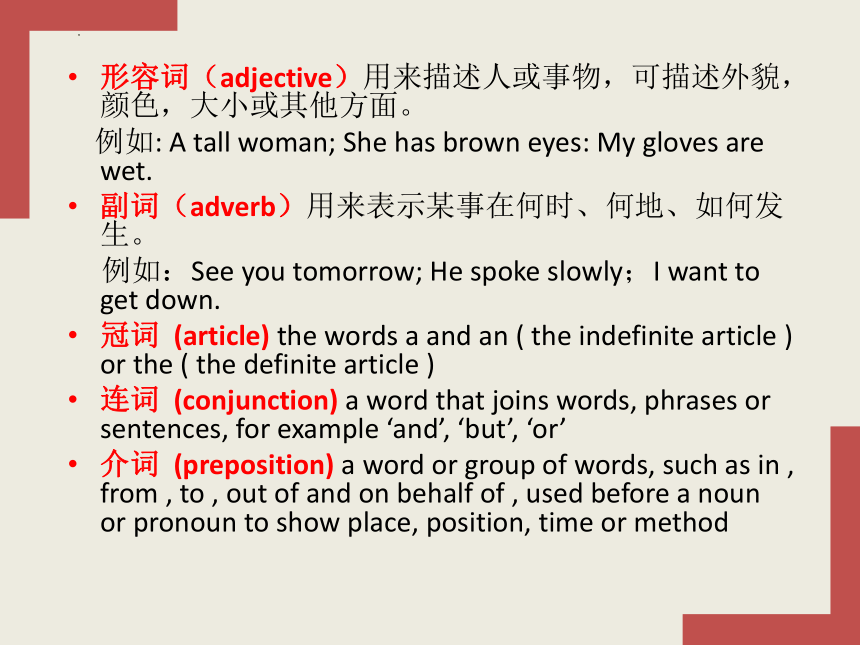

文档简介
(共23张PPT)
英语语法术语
WOR REPORT
Part of Speech 词性
名词 (noun) a word that refers to a person, (such as Ann or doctor ), a place (such as Paris or city ) or a thing, a quality or an activity (such as plant , sorrow or tennis )
个体名词 (individual noun)是指表示单个的人或事物的名词,是一类可以单个独立存在的人、动植物、和团体的名称。个体名词通常是可数名词。
集体名词 (collective noun)表示一群人或一些物的名词叫集体(或集合)名词。为便于弄清其特点,我们不妨把它们分为表示无生命的物的“类”和表示主要是由人(有少数是低等动物)构成的“群”的集体名词。
物质名词(Material Noun)表示无法分为个体的实物。一般包括材料、食品、饮料以及固体、液体、气体的物质名称或化学元素名称,例如:wood(木料),meat(肉),wine(酒),paper(纸),ink(墨水),gas(气体),water(水),oxygen(氧)等。
抽象名词: abstract noun
可数名词: countable noun
不可数名词: uncountable noun
专有名词(Proper Nouns)是某个或某些人、地方、机构等专有的名称,如Beijing,China等;
普通名词(Common Nouns)是一类人或东西或是一个抽象概念的名词,如:book,sadness等。
动词 (verb) a word or group of words that expresses an action (such as eat ), an event (such as happen ) or a state (such as exist )
动态动词: dynamic verb
静态动词: stative verb
情态动词: modal verb
助动词(auxiliary verb)在完成时态和进行时态中,或疑问句、否定式和被动式中,与助动词和其他动词连用。英语中主要的助动词有 be, have 和 do.
例如: Is it snowing I have never been to Washington; we don’t have a computer at home. 情态动词也属于助动词。
非谓语动词: non-finite verbs
(分词, participle; 不定式, infinitive; 动名词, gerund)
代词 (pronoun) a word that is used instead of a noun or noun phrase, for example he , it , hers , me , them , etc.
人称代词 (personal pronoun)人称代词是表示"我"、"你"、"他"、"她"、"它"、"我们"、"你们"、"他们"的词。是表示自身或人称的代词。人称代词有人称、数和格的变化.
物主代词 (possessive pronoun)表示所有关系的代词叫做物主代词。物主代词可分为形容词性物主代词和名词性物主代词两种。
反身代词 (reflexive pronoun) 表示我自己,你自己,他自己,我们自己,你们自己,他们自己等的词叫做反身代词。反身代词第一,二人称构成是由形容词性物主代词加 "-self " (复数加 -selves ) 构成。第三人称反身代词是由人称代词宾格形式加 - self (复数加 - selves ) 构成。
指示代词 (demonstrative pronoun)表示这个,那个,这些,那些以及it,such,same等词叫做指示代词。指示代词在句中作主语,宾语,表语,定语。
关系代词 (relative pronoun)关系代词是用来引导定语从句的代词。关系代词有 who,whose,whom,that,which,as, 可用作引导从句的关联词,它们在句中可用作主语,表语,宾语,定语. 在主句中,它们还代表着从句所修饰的那个名词或代词(通称为先行词)。
不定代词 (indefinite pronoun)没有明确指定代替任何特定名词或形容词的词叫做不定代词,常用不定代词如下:all, any, another, both, each, either, few, little,many,much,none,neither,one,other,some以及由 some,any,no,every 和 body,one,thing 构成的复合词。
形容词(adjective)用来描述人或事物,可描述外貌,颜色,大小或其他方面。
例如: A tall woman; She has brown eyes: My gloves are wet.
副词(adverb)用来表示某事在何时、何地、如何发生。
例如:See you tomorrow; He spoke slowly;I want to get down.
冠词 (article) the words a and an ( the indefinite article ) or the ( the definite article )
连词 (conjunction) a word that joins words, phrases or sentences, for example ‘and’, ‘but’, ‘or’
介词 (preposition) a word or group of words, such as in , from , to , out of and on behalf of , used before a noun or pronoun to show place, position, time or method
句子成分
主语 (subject) 是一个句子的主题(theme),是句子所述说的主体.它的位置一般在一句之首.可用作主语的有单词、短语、乃至句子
谓语 (predicate) 或谓语动词(predicate verb) 的位置一般在主语之后.谓语由简单动词或动词短语(助动词或情态动词+主要动词)构成。
主谓一致: subject-verb agreement
宾语 (object)在句中主要充当动作的承受者,因此一般皆置于及物动词
补语(complement)是一种补足主语和宾语的意义的句子成分。补足主语意义的句子成分叫做主语补语(subject complement),补足宾语意义的句子成分叫做宾语补语(object complement)
定语 (attribute)是用来说明名词(代词)的品质与特征的词或一组词。可用作定语的有:形容词、名词、代词、数词、副词、不定式、动名词、分词、介词短语、从句和句子等。
状语 (adverbial)是修饰动词、形容词、副词以及全句的句子成分。
同位语 (appositive)当两个指同一事物的句子成分放在同等位置时,一个句子成分可被用来说明或解释另一个句子成分,前者就叫做后者的同谓语。这两个句子成分多由名词(代词)担任,同谓语通常皆放在其说明的名词(代词)之后。
句子 sentence
简单句 simple sentence含有一个谓语动词,主体结构是主谓(宾)和主系表。
并列句 compound sentence 简单句 + 并列连词+ 简单句。
复合句 (Complex Sentence) 分为并列复合句和从属/主从复合句,并列复合句是有并列连词:and、or、but连接;从属复合句由一个主句(Principal Clause)和一个或一个以上的从句(Subordinate Clause)构成。用疑问词作引导词,主句是全句的主体,通常可以独立存在;从句则是一个句子成分,不能独立存在。从句不能单独成句,但它也有主语部分和谓语部分,就像一个句子一样。所不同在于,从句须由一个关联词(connective)引导。
陈述句: Declarative sentence是用来阐述某个事实的句子,一般以句号结尾。
疑问句: interrogative sentence用来提出问题。疑问句又可分为四类:
(1) 一般疑问句general question
(2) 特殊疑问句special question
(3) 选择疑问句alternative question
(4) 反意疑问句disjunctive question
祈使句: imperative sentence是表示命令的句子,以句号或者感叹号结尾。
感叹句: exclamatory sentence是用来表达强烈情感的句子,或者惊喜,或者生气,或者惊吓等等。
从句(clause)的分类
名词从句 nominal clause
定语从句 attributive clause
主语从句 subject clause
同位语从句 appositive clause
状语从句 adverbial clause
时间状语从句 adverbial clause of time
地点状语从句 adverbial clause of place
方式状语从句 adverbial clause of manner
让步状语从句 adverbial clause of concession
原因状语从句 adverbial clause of cause
结果状语从句 adverbial clause of result
目的状语从句 adverbial clause of purpose
条件状语从句 adverbial clause of condition
宾语从句 object clause
时态(Tense)
一般现在时 present simple tense
一般过去时 past simple tense
一般将来时 future simple tense
过去将来时 past future tense
现在完成时 past perfect tense
过去完成时 present perfect tense
将来完成时 future perfect tense
过去将来完成时 past future perfect tense
现在进行时 present progressive tense
过去进行时 past progressive tense
将来进行时 future progressive tense
过去将来进行时 past future progressive tense
现在完成进行时 present perfect progressive tense
过去完成进行时 past perfect progressive tense
将来完成进行时 future perfect progressive tense
过去将来完成进行时past future perfect progressive tense
语态 voice
主动语态 active voice
主动语态表示主语是动作的执行者.
被动语态 passive voice
被动语态表示主语是动作的承受者。
被动语态是动词的一种特殊形式,一般来说,只有需要动作对象的及物动词才有被动语态。汉语往往用"被""受""给"等被动词来表示被动意义 。
被动语态由“be动词+及物动词的过去分词”构成。被动语态的时态变化只改变be的形式,过去分词部分不变。疑问式和否定式的变化也如此。
语气 mood
陈述语气 indicative mood
祈使语气 imperative mood
虚拟语气 subjunctive mood
否定 negation
否定范围 scope of negation
全部否定 full negation
局部否定 partial negation
转移否定 shift of negation
语序 order
自然语序 natural order
倒装语序 inversion
全部倒装 full inversion
部分倒装 partial inversion
直接引语 direct speech
间接引语 indirect speech
自由直接引语 free direct speech
自由间接引语 free indirect speech
一致 agreement
主谓一致 subject-predicate agreement
语法一致 grammatical agreement
概念一致 notional agreement
就近原则 principle of proximity
强调 emphasis
重复 repetition
语音 pronunciation
文体 style
正式文体 formal
非正式文体 informal
口语 spoken/oral English
套语 formulistic expression
英国英语 British English
美国英语 American English
用法 usage
英语语法术语
WOR REPORT
Part of Speech 词性
名词 (noun) a word that refers to a person, (such as Ann or doctor ), a place (such as Paris or city ) or a thing, a quality or an activity (such as plant , sorrow or tennis )
个体名词 (individual noun)是指表示单个的人或事物的名词,是一类可以单个独立存在的人、动植物、和团体的名称。个体名词通常是可数名词。
集体名词 (collective noun)表示一群人或一些物的名词叫集体(或集合)名词。为便于弄清其特点,我们不妨把它们分为表示无生命的物的“类”和表示主要是由人(有少数是低等动物)构成的“群”的集体名词。
物质名词(Material Noun)表示无法分为个体的实物。一般包括材料、食品、饮料以及固体、液体、气体的物质名称或化学元素名称,例如:wood(木料),meat(肉),wine(酒),paper(纸),ink(墨水),gas(气体),water(水),oxygen(氧)等。
抽象名词: abstract noun
可数名词: countable noun
不可数名词: uncountable noun
专有名词(Proper Nouns)是某个或某些人、地方、机构等专有的名称,如Beijing,China等;
普通名词(Common Nouns)是一类人或东西或是一个抽象概念的名词,如:book,sadness等。
动词 (verb) a word or group of words that expresses an action (such as eat ), an event (such as happen ) or a state (such as exist )
动态动词: dynamic verb
静态动词: stative verb
情态动词: modal verb
助动词(auxiliary verb)在完成时态和进行时态中,或疑问句、否定式和被动式中,与助动词和其他动词连用。英语中主要的助动词有 be, have 和 do.
例如: Is it snowing I have never been to Washington; we don’t have a computer at home. 情态动词也属于助动词。
非谓语动词: non-finite verbs
(分词, participle; 不定式, infinitive; 动名词, gerund)
代词 (pronoun) a word that is used instead of a noun or noun phrase, for example he , it , hers , me , them , etc.
人称代词 (personal pronoun)人称代词是表示"我"、"你"、"他"、"她"、"它"、"我们"、"你们"、"他们"的词。是表示自身或人称的代词。人称代词有人称、数和格的变化.
物主代词 (possessive pronoun)表示所有关系的代词叫做物主代词。物主代词可分为形容词性物主代词和名词性物主代词两种。
反身代词 (reflexive pronoun) 表示我自己,你自己,他自己,我们自己,你们自己,他们自己等的词叫做反身代词。反身代词第一,二人称构成是由形容词性物主代词加 "-self " (复数加 -selves ) 构成。第三人称反身代词是由人称代词宾格形式加 - self (复数加 - selves ) 构成。
指示代词 (demonstrative pronoun)表示这个,那个,这些,那些以及it,such,same等词叫做指示代词。指示代词在句中作主语,宾语,表语,定语。
关系代词 (relative pronoun)关系代词是用来引导定语从句的代词。关系代词有 who,whose,whom,that,which,as, 可用作引导从句的关联词,它们在句中可用作主语,表语,宾语,定语. 在主句中,它们还代表着从句所修饰的那个名词或代词(通称为先行词)。
不定代词 (indefinite pronoun)没有明确指定代替任何特定名词或形容词的词叫做不定代词,常用不定代词如下:all, any, another, both, each, either, few, little,many,much,none,neither,one,other,some以及由 some,any,no,every 和 body,one,thing 构成的复合词。
形容词(adjective)用来描述人或事物,可描述外貌,颜色,大小或其他方面。
例如: A tall woman; She has brown eyes: My gloves are wet.
副词(adverb)用来表示某事在何时、何地、如何发生。
例如:See you tomorrow; He spoke slowly;I want to get down.
冠词 (article) the words a and an ( the indefinite article ) or the ( the definite article )
连词 (conjunction) a word that joins words, phrases or sentences, for example ‘and’, ‘but’, ‘or’
介词 (preposition) a word or group of words, such as in , from , to , out of and on behalf of , used before a noun or pronoun to show place, position, time or method
句子成分
主语 (subject) 是一个句子的主题(theme),是句子所述说的主体.它的位置一般在一句之首.可用作主语的有单词、短语、乃至句子
谓语 (predicate) 或谓语动词(predicate verb) 的位置一般在主语之后.谓语由简单动词或动词短语(助动词或情态动词+主要动词)构成。
主谓一致: subject-verb agreement
宾语 (object)在句中主要充当动作的承受者,因此一般皆置于及物动词
补语(complement)是一种补足主语和宾语的意义的句子成分。补足主语意义的句子成分叫做主语补语(subject complement),补足宾语意义的句子成分叫做宾语补语(object complement)
定语 (attribute)是用来说明名词(代词)的品质与特征的词或一组词。可用作定语的有:形容词、名词、代词、数词、副词、不定式、动名词、分词、介词短语、从句和句子等。
状语 (adverbial)是修饰动词、形容词、副词以及全句的句子成分。
同位语 (appositive)当两个指同一事物的句子成分放在同等位置时,一个句子成分可被用来说明或解释另一个句子成分,前者就叫做后者的同谓语。这两个句子成分多由名词(代词)担任,同谓语通常皆放在其说明的名词(代词)之后。
句子 sentence
简单句 simple sentence含有一个谓语动词,主体结构是主谓(宾)和主系表。
并列句 compound sentence 简单句 + 并列连词+ 简单句。
复合句 (Complex Sentence) 分为并列复合句和从属/主从复合句,并列复合句是有并列连词:and、or、but连接;从属复合句由一个主句(Principal Clause)和一个或一个以上的从句(Subordinate Clause)构成。用疑问词作引导词,主句是全句的主体,通常可以独立存在;从句则是一个句子成分,不能独立存在。从句不能单独成句,但它也有主语部分和谓语部分,就像一个句子一样。所不同在于,从句须由一个关联词(connective)引导。
陈述句: Declarative sentence是用来阐述某个事实的句子,一般以句号结尾。
疑问句: interrogative sentence用来提出问题。疑问句又可分为四类:
(1) 一般疑问句general question
(2) 特殊疑问句special question
(3) 选择疑问句alternative question
(4) 反意疑问句disjunctive question
祈使句: imperative sentence是表示命令的句子,以句号或者感叹号结尾。
感叹句: exclamatory sentence是用来表达强烈情感的句子,或者惊喜,或者生气,或者惊吓等等。
从句(clause)的分类
名词从句 nominal clause
定语从句 attributive clause
主语从句 subject clause
同位语从句 appositive clause
状语从句 adverbial clause
时间状语从句 adverbial clause of time
地点状语从句 adverbial clause of place
方式状语从句 adverbial clause of manner
让步状语从句 adverbial clause of concession
原因状语从句 adverbial clause of cause
结果状语从句 adverbial clause of result
目的状语从句 adverbial clause of purpose
条件状语从句 adverbial clause of condition
宾语从句 object clause
时态(Tense)
一般现在时 present simple tense
一般过去时 past simple tense
一般将来时 future simple tense
过去将来时 past future tense
现在完成时 past perfect tense
过去完成时 present perfect tense
将来完成时 future perfect tense
过去将来完成时 past future perfect tense
现在进行时 present progressive tense
过去进行时 past progressive tense
将来进行时 future progressive tense
过去将来进行时 past future progressive tense
现在完成进行时 present perfect progressive tense
过去完成进行时 past perfect progressive tense
将来完成进行时 future perfect progressive tense
过去将来完成进行时past future perfect progressive tense
语态 voice
主动语态 active voice
主动语态表示主语是动作的执行者.
被动语态 passive voice
被动语态表示主语是动作的承受者。
被动语态是动词的一种特殊形式,一般来说,只有需要动作对象的及物动词才有被动语态。汉语往往用"被""受""给"等被动词来表示被动意义 。
被动语态由“be动词+及物动词的过去分词”构成。被动语态的时态变化只改变be的形式,过去分词部分不变。疑问式和否定式的变化也如此。
语气 mood
陈述语气 indicative mood
祈使语气 imperative mood
虚拟语气 subjunctive mood
否定 negation
否定范围 scope of negation
全部否定 full negation
局部否定 partial negation
转移否定 shift of negation
语序 order
自然语序 natural order
倒装语序 inversion
全部倒装 full inversion
部分倒装 partial inversion
直接引语 direct speech
间接引语 indirect speech
自由直接引语 free direct speech
自由间接引语 free indirect speech
一致 agreement
主谓一致 subject-predicate agreement
语法一致 grammatical agreement
概念一致 notional agreement
就近原则 principle of proximity
强调 emphasis
重复 repetition
语音 pronunciation
文体 style
正式文体 formal
非正式文体 informal
口语 spoken/oral English
套语 formulistic expression
英国英语 British English
美国英语 American English
用法 usage
同课章节目录
